

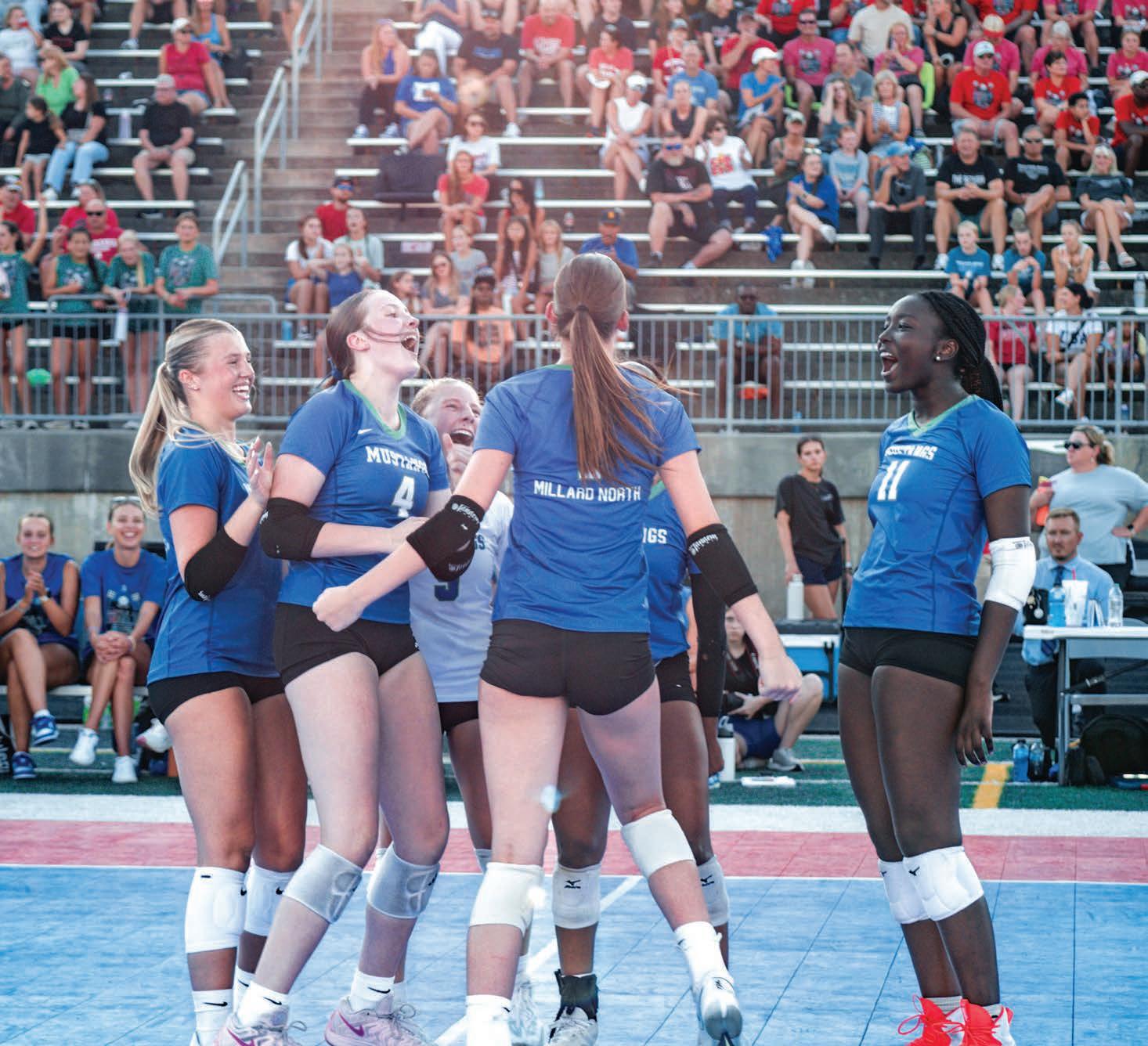




KATELYN JUDD
alumna
Johnson has accomplished in the 14 years since she graduated
News Editor especially when Johnson was Editor-In-Chief of both the newspaper and yearbook.
Lizzie Johnson, an alumna from MN’s class of 2011, returned a few weeks ago to her hometown, her high school, and her family to be inducted into the sixth class of the Millard North Hall of Fame. However, she also came to say her goodbyes before moving to Kyiv, Ukraine in the midst of a warzone.
Johnson is relocating to Ukraine for the next four years as a foreign correspondent for “The Washington Post.” Her role is to report on issues affecting the part of the world where she is assigned. One might feel hesitant about moving into a battlefield, but Johnson feels strongly about her decision and finds thrill in the challenge it provides.
“I’m the kind of person that’s drawn to really high-intensity stuff. I mean, clearly, I’m about to move into a warzone,” Johnson said. “I think I thrive off of being really busy and doing work that matters to me.”
This is Johnson’s fifth time in Ukraine, meaning that she is no stranger to war, even though she still hasn’t quite become accustomed to the dangers. Yet, she still cherishes the culture and people she’s met in the process, and tries to find light in a tough situation.
“There are moments where it’s really scary, where you’re under shelling all night and things are really loud,” Johnson said. “But then, the restaurants are incredible and everyone is so fashionable… and the culture is beautiful, so [both things] can exist at the same time.”
Despite experiencing the change of moving to another country, for Johnson, coming back to the U.S. has also been unexpected. Even though she lived in the U.S. for the majority of her life, she still experiences a certain culture shock, especially when visiting her high school during football season.
“I went to the Millard North football game, which was so American of all American experiences, and they played this siren noise during halftime. I was like, ‘Oh, that sounds like an air-raid siren,’ and if that were happening in Ukraine, everyone would start running for the bomb shelters. But cheerleaders are across the fields and kids are laughing,” Johnson said. “You don’t realize what a privilege that is until you don’t have it.”
Journalism adviser Sarah Crotzer had Johnson as a student throughout her high school career and worked closely with her. The two spent a lot of time together,
“Lizzie had this bell on her backpack, and I could always hear her coming down the hallway,” Crotzer said. “I was always reassured when I heard that bell, because I knew that Lizzie was going to take charge and help me figure things out.”
Although Crotzer knew Johnson was destined for big things, not every adult in her life took her and her dreams seriously.
“When I was a little girl growing up in Nebraska, being like, ‘I want to be a foreign correspondent,’ a lot of people didn’t take me seriously, and to get that opportunity to see a different culture, and to cover stories that really matter?” Johnson said, “I think the wonderful thing about journalism is that when you do these accountability pieces, you can show the reality of someone’s situation, you can spur change.”
After high school, Johnson graduated from the University of Missouri with a Bachelor’s degree in Journalism and a minor in Spanish, which she put to use during an internship in Buenos Aires, Argentina.
Spanish teacher and World Language department head Shaun Hoover was Johnson’s Spanish teacher. He was elated to receive her invitation to the Hall of Fame as the youngest inductee, and wasn’t surprised that Johnson went on to do amazing things.
“This is pretty cool to see her get recognized [in the hall of fame], especially in a profession that’s very judged at this moment,” Hoover said.
After completing many internships at locations like the “Chicago Tribune,” “Omaha World Herald,” and the “Dallas Morning News,” Johnson was offered a job at the “San Francisco Chronicle.”
Starting out, she covered City Hall in California for two years. She worked closely with politicians and reported on political issues that directly affected California. Needing a breath of fresh air and a change in environment, Johnson transferred to the GA, or general assignment desk, and dabbled in many different topics before finally settling on her calling: wildfires.
Johnson had spent a large portion of her time reporting on the 2018 wildfires in California. In order to get a first-person perspective, Johnson put herself on the front lines of the deadliest wildfire in California and United States history. Afterwards, she wrote a book about her experience and the people she had met along
the way.
Johnson’s book, “Paradise: One Town’s Struggle to Survive an American Wildfire,” was published in 2021, and after the substantial success of her novel, the rights were sold to Blumhouse Productions (which includes big-name producers like Jamie Lee Curtis and Jason Blum) to create a movie.
With Johnson working as an executive producer on her movie, she worked alongside other producers to not only create an imaginative movie but also to stay true to the novel’s gravity and hard-hitting reality of what happened in Paradise, California.
“[Jamie Lee Curtis] had such a big heart, and knows that the story requires a lot of substantivity, because it’s not just a movie. It was the worst day of a lot of people’s lives,” Johnson said.
The core of the movie was taken from an excerpt in Paradise, where Johnson discovered a bus driver by the name of Kevin McKay (portrayed by Matthew McConaughey on screen). McKay responded to an emergency call regarding 22 elementary students who needed rescuing.
McKay rescued the students and their teacher, Mary Ludwig (played by America Ferrera), and drove 30 miles to safety on a road engulfed in flames on both sides. The movie, The Lost Bus, premiered on September 5, 2025, at the Toronto International Film Festival and will be released globally on October 3, 2025, on Apple TV+.
After her success with her first book, Johnson isn’t quite sure what her next project will turn out to be. She’s on the lookout for what will motivate her to pick up her pencil.
“I feel like there’s probably a second book in Ukraine somewhere,” Johnson said. “I don’t want to [write another book] just for the sake of doing it. It has to be something that I can’t stop thinking about. Thinking about it while eating dinner, when I’m falling asleep at night, and then I wake up thinking about it.”
Now, Johnson is eight hours ahead of CST, and is oceans and a continent away. But based on her previous work, Johnson focuses on impactful and emotional work, where she tells the stories of people.
“I think there’s so much that we don’t have control over in our lives, and sometimes it feels like things are just happening to us, especially nowadays, and so the ability to do a little bit of good, I think that’s what keeps you going,” Johnson said.

• Heisman Trophy (2001)
• Walter Camp Player of the Year (2001)
• Davey O’ Brien Award (2001)
• Big 12 Offensive Player of the Year (1999/2001)
• Gatorade Player of the Year (1996)

On August 27th, 2025, Eric Crouch’s name found a permanent place on the MN campus after a street was named in his honor. Crouch graduated from MN in 1997, after an immensely successful high school football career as quarterback. He went on to continue his education and play football at the University of Nebraska: Lincoln, where Crouch became a Husker football legend. His high school football coach Fred Petito credits Crouch’s achievements to his work ethic that set him apart from the others.
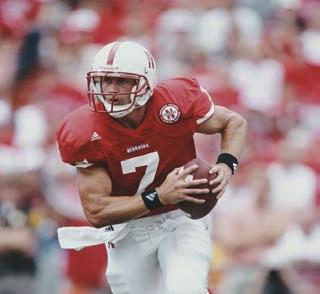

“I just really hope that this sign really inspires someone else to do great things,” Crouch said.


Retired 2022
Begley began his career at MN in 1992 as an English teacher, before serving 15 years as principal, where he promoted excellence, school spirit, and inclusivity. After retiring in 2022, he became the principal of Bluestem Middle School, continuing his legacy of building strong school communities.
Class of 2011
During her time at MN, Johnson was an excellent student in journalism and the classroom. She studied journalism at the University of Missouri, and later wrote a book about the California wildfires that became a movie. She now works for “The Washington Post”and is moving to Ukraine as a foreign correspondent.
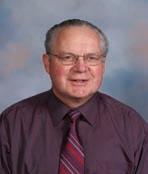

Lenz was part of the original faculty at MN when the school opened in 1978. For 33 years, Lenz was dedicated to his role as the Guidance and Counseling Department Head. He had a passion for education and working with students.
Retired
Petitio was a well-known figure at MN as the head football coach from 1983-2024. He led the team to five state championships and eight total finals appearances.

In June 2022, Jamie Lee Curtis and Jason Blum began developing the film as producers, an adapatation of Lizzie Johnson’s novel. In January 2024, Paul Greengrass took the role of director and Matthew McConaughey was cast to star. In February 2024, America Ferrera joined the cast, and Apple was confirmed as the streaming platform for the film.
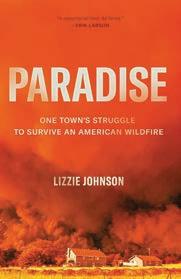
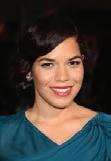
plays the role of Mary Ludwig (teacher).


Matthew McConaughey plays the role of Kevin McKay (bus driver).
Watch on October 3rd, 2025 on Apple TV+.


Poole was an outstanding track and field athlete and was a State Champion in the 3200 meters in 1980. Later, Pool was sworn in as a member of the Millard Public Schools Board of Education in 1997 and has held multiple terms as the President.
Salberg began teaching and coaching at MN in 1981, where his Law Studies class made a lasting impact on students. Known for his humor, high standards, and memorable nicknames, Salberg inspired many students to pursue careers in criminal justice.

Exploring Kathy Folk’s lasting impact in the community throughout her cancer journey
MIRA MUKHERJEE
Co-Editor-in-Chief
riday, April 13, 2012. An unremarkable spring day for most, but for Activities Secretary Kathy Folk, it was a day she would never forget. After experiencing severe side pain the prior weekend, a subsequent trip to the doctor’s office led to that Friday’s fateful diagnosis: stage four Non-Hodgkin’s follicular lymphoma.
“I literally felt myself melt down the wall,” Folk said. In the next month, Folk would begin treatment at Nebraska Medicine under the care of world-renowned specialists in lymphoma, initially with Dr. James O. Armitage.
“People flew in from all around the world to see this man, and I had to drive 20 minutes,” Folk said. Folk would achieve remission, but four years later, she would find out her cancer had returned. She began treatment with Dr. Matthew A. Lunning, who has now been treating her for the last nine years. Since her initial diagnosis, Folk has had multiple cancer recurrences and completed a variety of treatments, from chemotherapy to a stem cell transplant.
In February 2025, Folk found out that her cancer had returned for the fourth time, and along with Lunning’s recommendation, decided to do something revolutionary: outpatient CAR-T therapy.
“He said if you think you could recuperate at home, I think you would be the best candidate,” Folk said.
CAR-T therapy is a type of immunotherapy in which a person’s own immune cells are trained to destroy cancer cells.

Doctor-Knows-Best
Kathy Folk stands with her two doctors, Dr. Lunning (left) and Dr. Armitage (right) at the Leukemia and Lymphoma Society Nebraska chapter. Lunning was named Man of the Year at this convention.
Photograph contributed by Kathy Folk
Typically, the treatment requires the patient to stay in the hospital for roughly two weeks after the infusion process, but Folk was able to qualify for the outpatient route because she could be monitored closely at home and go to the hospital for daily check-ups.
Folk was the first patient in Nebraska to complete the outpatient route for CAR-T therapy, and on Aug. 11, 2025, after clear scans, Folk was declared in remission.
“I feel like I’ve been given a new lease on life,” Folk said.
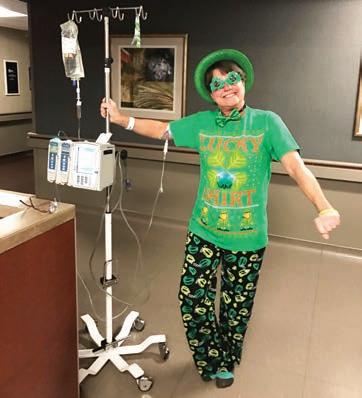
Green Galore
Kathy Folk stands decked out in green during treatment on St. Patrick’s Day. She is not only wearing green for the holiday, but also for non-Hodgkin’s awareness.
Photograph contributed by Kathy Folk
As Folk has been at MN for ten years, all of her time here has been punctuated by her cancer journey. Despite her long-standing health battle, Folk maintained unwavering support for the school community. For junior Abby Beard, a member of the softball team, Folk’s presence has made a significant impact.
“With her and her husband, every single game they come to, he yells whenever we score, saying ‘Let’s Go, Mustangs!’ super loudly, and it’s so fun and everyone cheers,” Beard said. “She just laughs, and you can just see the smile on her face; she’s just been so supportive to us during such a difficult time for her.”
A wide variety of teams, clubs, and associations have come together to support Folk. From green (the color for Non-Hodgkins lymphoma) hair ribbons the softball team donned for games to T-shirts staff members designed in support of Folk, shows of encouragement have been seen throughout the school.
“We have rallied behind her every step of her journey. When Kathy lost her hair the first time, when she came into the office, we played ‘You Are So Beautiful.’ There is nothing better than the staff here at Millard North,” secretary Theresa Rude said.
The multitude of uplifting events has fostered a positive environment for Folk.
“All of these kids and all of their energy, as well as the teachers and staff, have helped me get where I’m at,” Folk said.
The support system at school has been strengthened by Folk’s own passion for its com-
munity, having far-reaching effects.
“Her showing how much she cares and loves all of us, and just really the smile she continually puts on her face every single day…it taught myself and the team to put things in perspective, and to be thankful for every opportunity you’re given in life,” Beard said. “She just has really had a very big impact in my time at Millard North.”
Even though Folk is retiring at the end of this school year, her presence will continue to be felt not only at school but also in Omaha, as she plans to do cancer outreach work.
Now a part of Community Scientists, a program at the Fred and Pamela Buffett Cancer Center, Folk reads over cancer treatment proposals, provides feedback on advertisements, and partakes in additional advocacy work.
“You always wonder why something happens to you…this whole thing may have happened because I’m supposed to help people get this [treatment] now,” Folk said.
Folk will continue to spread awareness about her journey and unique treatment, facilitating increased knowledge surrounding cancer.
“I know a lot of people that have cancer, and they don’t want anybody to know about it. They want to go through it quietly, which is fine, but that’s not my personality,” Folk said. “I think it’s helped all of my family for me to be more outspoken because they’re not afraid…by being able to explain your story, I think it just helps people.”

JAYDEN MAPLE Staff Writer
or tourists, taking in the beauty of new and exciting destinations can open up the world in new ways, leading to memories that could last a lifetime. With many places to explore, there doesn’t seem to be an end in sight for the land we can explore.
From the city of Munich in Germany to the mountains of Switzerland, and the small country of Liechtenstein, juniors Nick Buscher and Elaina Dethloff, as well as German teacher Wendy Brennan, decided to take their language skills from the classroom to the land of Central Europe. Their goal was to practice their language skills in real-life situations, along with exploring what the rich culture had to offer them.
“I’ve always admired Europe and thought it was a different place, and I would want to see the culture there and just how it compares to ours, “ Buscher said.
Did you know that in Germany, the law ‘Ruhezeit’ prohibits that during the hours of 10 p.m. and 6 a.m., and on Sundays, it is illegal to operate loud machinery? This includes activities like mowing the lawn or using a vacuum cleaner.
Source: Lingoda
The free time on their trip had benefited the students, since they could now use those skills they learned from locals for future tests and assignments.
Even with the challenges of travel, the students found ways to either overcome them or find a new opportunity to rise up to the challenge.

From the end of May to the second week of June, they explored many sides of history and culture, with students visiting the many cultural sights of Zurich, Switzerland, and Vienna, Austria, exploring the Alps and many shops, like the jewelry shop Swarovski in the middle of Zurich.
The students pose for a photo with the scenic backdrop in front of the water. They are getting ready to experience the picturesque landscape Germany has to offer.
Photograph contributed by Wendy Brennan
“I’m not that big of a jewelry person, but if it weren’t for this trip, I wouldn’t have gotten to see this,” Brennan said.
Students also tested their German abilities throughout the trip, particularly when Buscher interacted with local speakers of the language.
“I tried to use my skills when I could. There are some parts when I would order a particular food at a restaurant or something like that, I didn’t want it to be messed up, but I did use it in broader situations, and I did try to use them when I had the chance,” Buscher said.
Buscher used his skills when he went to a skateboard shop in Vienna, Austria.
“During our free time, I had the opportunity to visit a local shop, and I ended up talking with the guy for about an hour about my passion for skateboarding. I tried to use my skills while talking to them, but whenever I couldn’t pronounce something, I would just use English,” Buscher said.
“When we flew into Amsterdam, our flight ended up getting canceled, so we ended up exploring Amsterdam on our own. We explored a famous museum while waiting for our flight. Even if the weather wasn’t to our liking, we were happy that we got a 5th country on our trip,” Brennan said.
Their short adventure to Amsterdam gave each of them something to remember, like when they visited the Rijksmuseum, a museum with many famous art pieces, like Van Gogh’s self-portrait, which made the detour worthwhile on their short layover.
Despite their prior skills in the classroom, sometimes the language barrier was presented in some ways that they didn’t expect.
“We went to this restaurant, and the menu was in a certain dialect of German that we haven’t discussed as much in the classroom. Even if there was an online menu in English, they made it very clear that they speak their language here, but we discussed the menu together, and everyone was able to find something they liked,” Brennan said.
With Europe being the most visited continent in the world, the opportunities to immerse themselves in a new culture are all over. The students say that it would be a good experience for others wanting to travel out of the country.
“I’d definitely recommend it. It’s unique, and you’re gonna see a whole new land on a different side of the world. You shouldn’t just be stuck in one place all your life. You should explore the world and see what it has to offer,” Buscher said.
Only time will tell when students will return to the place they considered to be one of the best in their minds.
Overall, these students learned and they experienced what was all there. With the many moments that they spent together, coming back is most likely on their minds.
“I definitely would come back, but most likely with a larger group of people,” Dethloff said.
For now, back home and with a new perspective on life, they can say that they had the adventure of a lifetime.
“I just had a wonderful time, [the students] were wonderful to travel with, and it just really excited me, and it really reignited my passion for travel with my students,” Brennan said.
Omaha’s Mayor initiates a Homeless Encampment Plan (Sept. 22)
Conservative speaker Charlie Kirk assassinated at event at Utah Valley University (Sept. 10)
MIT collaborates with Idaho National Laboratory to progress America’s nuclear industry (Sept. 22)
Biologists discover ‘the bumpy snailfish,’ a new species of fish in the Pacific Ocean (Sept. 9)
Typhoon Ragasa has caused mass evacuations in southern China of 100,000+ people (Sept. 23)
How a collaboration between three Millard Schools led to a united performance at Millard Days
NATHAN YEH Staff Writer
or the first time in the Millard Days Festival’s over 50year history, the community had the privilege of seeing three high school bands, Millard South, Millard West, and Millard North, perform together at the parade, the culmination of the festival.
The festival is an annual event serving the Millard community, which hosts various activities, including the parade and carnival. This week-long festival held at the end of August ushers in a cheerful spirit as students head back to school.
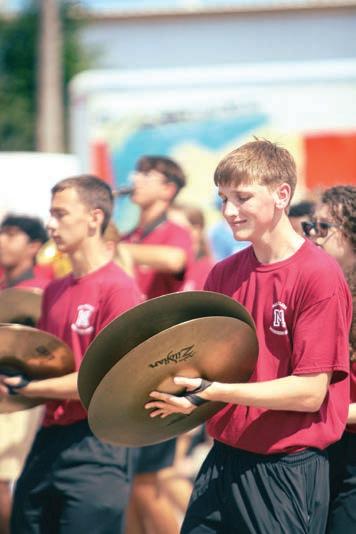
A Cymbal Clap
Senior Bret Selman plays his cymbals during the band’s performance at Millard Day.s. The band members are dressed in the same uniform to signify their unity as one.
Photograph by Emauel
Biaz
This year, the Millard Days Festival returned for its 58th year. The fair provided an opportunity for people from all parts of the community to meet, connect, and enjoy entertainment together.
The parade also featured a tribute to veterans, a cheerleading and karate show, luxurious sports cars, and many more interesting festivities. Festival-goers also enjoyed the grand parade performance of the three combined schools.
“John Keith, the director at Millard West, first brought the idea to us. He thought it would be fun to eventually audition for the Rose Bowl Parade, but before that, it made sense to do a trial run together. He suggested we combine for Millard Days to see how it worked as we lined up our music, drum cadences, color guards, and everything else,” Craig Mathis, the new head band director at Millard North, said.
This year, the Millard North Band program has 253 students. When the bands from Millard North, Millard South, and Millard West practiced together for the festival, there were approximately 550 students altogether on one field. As
a result, preparation for this event presented numerous challenges.
“The biggest issue was sound delay because we were so spread out. To help, percussion played more strongly than usual to give everyone a steady pulse to march to,” Mathis said.
Wearing
Synchronizing the bands in a way that they could work together proved to be a challenge during practices as well.
“Each band has slightly different marching styles and ways of holding instruments. When we met, we unified those into something close to what all three already did,” Mathis said.
The combined practices allowed the students to get to know each other better before the festival event.
“You just have to be willing to be outgoing and talkative to get to know other people,” senior Linnea Krizmanich said.
At the parade, the band students from the combined schools were all sporting the same maroon-colored uniform.
Instead of competing against each other, the parade uni fied the students into a project where they came together to celebrate a community to which they all belong.
“If we wore different uniforms, people might compare schools or think one is better than another.
Wearing the same thing made us one band instead of three separate ones,” Krizmanich said.
As they paraded down the street, the inspirational tunes of Pink’s “Raise Your Glass” played. The song’s theme of cheering for people of diverse backgrounds served as a message of encouragement.
The audience
could feel the energy in the air as the beautiful combined sounds of the Millard North, Millard South, and Millard West bands worked together in sync.
“
“I really like performances, because I love to see the energy of the students when they get off the field and have that sense of accomplishment. When they walk in with a big smile, and they know they really did something good, and they did it well— that feels great,” Mathis said.
The assembling of the three bands resulted in one of the most unique performances Omaha has ever seen.
“Parades are a great way to bring the band to people who might not usually see us perform. It exposes younger kids to music and shows them how fun a band can be. It also brings joy to people who just enjoy music, even if they don’t play an instrument themselves,” Krizmanich said.


THE HOOFBEAT
Staff Editorial
y first period, the hallway already smells like yesterday’s soda -- sweet, sharp, a little stale. Fruit flies loop above blue rims scuffed white at the edges, and a ribbon of tea glints across the linoleum toward a poster that says “reduce, reuse, recycle.” The scene is loud without a sound: good intentions, rotting.
We didn’t lose recycling because the school failed us. We lost it because students kept tossing food and half-full drinks into the blue bins, contaminating whole bags, leading to them being sent to the landfill and covering special education students in filth. Until we change our habits, recycling can’t work here.
Years ago, former environmental science teacher Meghan Callaghan secured a Hubbard Foundation grant that covered the cost of the bins, provided liners, and funded a monthly recycling dumpster. According to Principal Aaron Bearinger, that seed money got the system moving and kept it afloat for a while.
But soon the workload outgrew goodwill. Having more than 100 classrooms turned a simple route for special education students into a daily marathon. The Alternative Curriculum Program (ACP) stepped in with carts, clipboards, and a rotation to make the rounds.
But contamination changed the job. Some rooms had clean paper and bottles; others hid half-full cups and food. When ACP students lifted a bag, the liquid pooled at the bottom splashed out or the bag tore, soaking their sleeves—and once a bag is wet, the whole load goes to the landfill.
This is where the cost became human. ACP teacher Alexa Ryan watched ACP students come back wet and

How do you feel about MN’s removal of recycling?.
I
sticky after collecting contaminated recycling bins, changing into new shirts, and missing instruction while classmates moved on. Pride drains fast when your afternoon is defined by someone else’s leftovers.
The toll piled up in quiet ways. A nudge about a bin that wasn’t pulled. A late arrival to class with damp sleeves and a shrug that says, “I tried.” A lesson lost to cleanup, then another to finding clean clothes.
The ACP students still chased pride where they could. They liked being useful, pushing a cart with purpose, and waving at students when picking up the bins. But that feeling is fleeting when a single careless toss can reroute your whole day.
While the human cost piled up, the financial one wasn’t far behind. The grant ended last year, and the dumpster bill landed in the school budget. Paying for pickups that might be mostly contaminated doesn’t feel like stewardship; it feels like a shrug.
None of this argues against recycling. It fights against a model built on heroics instead of design. The rebuilding of recycling starts with us students.
No student should be soaked in another kid’s drink to keep the building “green.” ACP students handle pickup and deserve clean, dry bags and respect. If the job leaves them sticky or embarrassed, the system has to change.
Changing the system means changing the details students meet at the bin. Start with design—bold, eye-level labels at every bin cluster, add “empty-liquids” stations right beside the bins, and create new lids that have narrow openings so trash doesn’t slide in and puddles don’t start forming.
don’t think it’s a good idea because there’s usually a lot of litter scattered around.
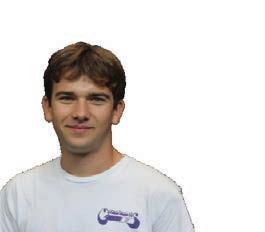
The grant should be
renewed
because recycling is really important to keep sustainJulian Wrubel “

Shonoah Dean
It takes away opportunities from special needs students who take care of recycling.

Isaiah Jacobson “
MN should keep recycling because it has a positive effect on the environ-
But design alone can’t fix our recycling system—responsibility and work have to be distributed. We can do this by keeping ACP students involved without making them carry the building. Launch a student Green Team for training and spot checks, and select a bin captain in each classroom to catch contamination before it starts.
Mainly, we have to reinforce habits in ourselves and our friends. You can start with a simple mantra: empty, dry, in.
Measure what matters: how many bags stay clean, how many get tossed for spills, and how often we really need a pickup. Share the weekly numbers in the hallway and recognize the classes doing it right.
Most of all, center the people who do the work. The best days are when students feel capable and connected, not sticky and sidelined. According to Principal Aaron Bearinger, sustainability depends on shared ownership and a structure that survives graduation.
Ending a broken system is honest. But ending the idea of recycling would be a mistake. We have to take responsibility in order to bring the blue bins back. We start with preserving ACP students’ dignity, smart design next, and schoolwide commitment always—so the hallway finally smells like nothing at all.
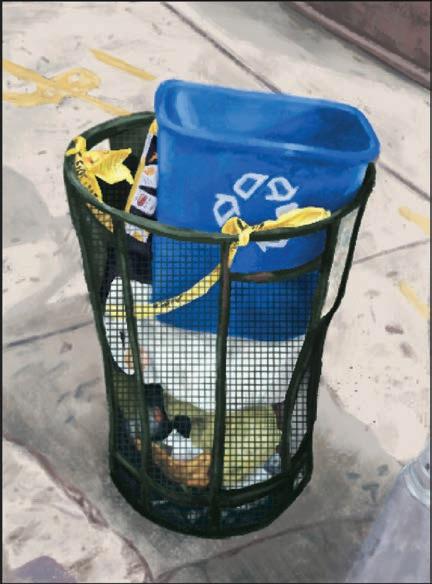
By Nadirah Johnson







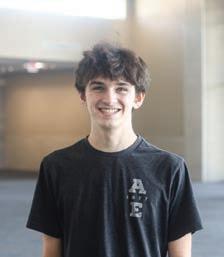
inned between outdated handouts and random club schedules, an internship flier hides on one of UNO’s many bulletin boards. To most, it’s overlooked as another silly advertisement. To curious students with sharp eyes, this flier is a golden ticket.



By building connections, students can find friends in hidden sectors of any future field. These connections can create shortcuts to big opportunities down the line.
As a student lacking connections, I never seem to hear about these rich opportunities, and midnight searching on the internet never pans out. When I ask my peers how they landed their summer programs, they always tend to say something along the lines of “a friend of a friend,” or “my dad’s coworker.”
According to Forbes, a study revealed that 91% of students indicated that the most important factor in landing interviews was connections.

Internship opportunities are like holy grails for devoted students. They offer handson experience in a field they’re both curious about and unfamiliar with. By gaining workplace experience, students can be put to ease when deciding future career paths.

These hands-on experiences give students a chance to apply the knowledge they learn in school to real-life scenarios.
Internships show college admission officers responsibility and heightened interest. According to BigFutureStudent, applicants with internship experience stand out more amongst other candidates.
However, these programs aren’t easily accessible for everyone.

For starters, internships are highly competitive. According to Fortune, the number of applications per internship have doubled since 2023. This increasing competition and interest make the number of available spots scarce.



However, these connections can actually raise some ethical issues. Networking bias is the unconscious tendency to choose people we know over those we don’t, even if they’re more qualified. While this is useful for someone with connections, these biased acceptances actually strip dedicated workers of opportunities.





















and lucrative careers.



According to ResearchGate, cronyism—the tendency to choose associates or connections over more qualified individuals—reduces the incentive to take advantage of educational opportunities. They found that when connection bias exceeds a certain threshold, the competition and applicant pool increases, therefore decreasing the percentage of selected candidates and limiting students’ opportunities.

Secondly, the application process is hardly unbiased. When it comes to high school programs, grades, pas-sion, and community involvement all contribute to the final decision. However, some students loop around this application process through so-cial networking.
This bias especially impacts STEM and research fields. Most of these programs involve hands-on work with chemicals, tools, and data in labs. They offer students a chance to apply their skills and knowledge to meaningful analysis. Yet, when open spots are limited, these benefits are consistently inaccessible to students due to networking bias.
This favoritism also has a considerable impact on low-income students. Students from low-income homes use these big opportunities to climb social ladders and break economic barriers. They’re able to bolster their reputation, apply to more prestigious schools, and even go on to pursue higher education
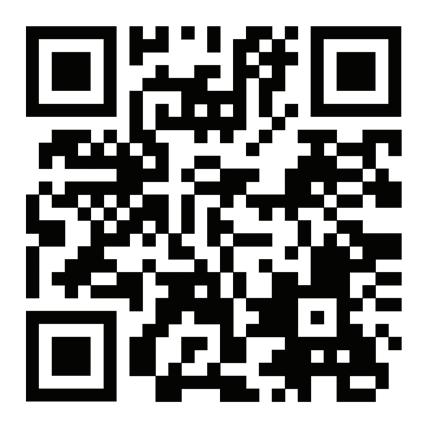
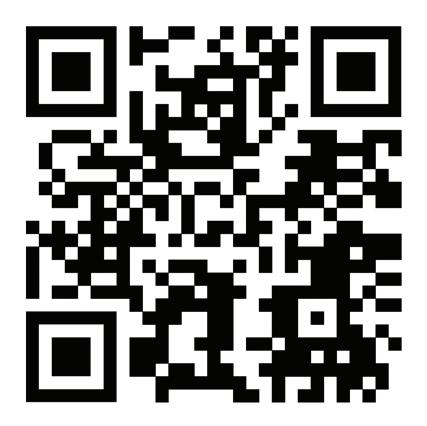
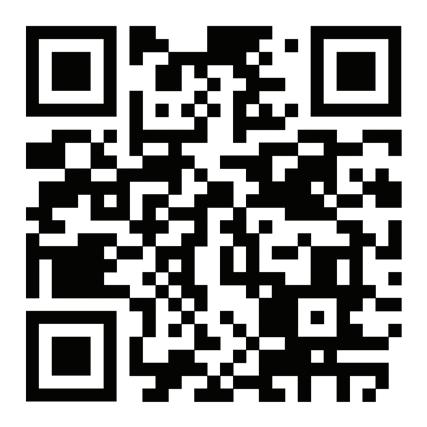














However, this process is difficult without the aid of connections.Low-income students are less likely to have connections that can get them interviews or research positions. More connected schools are also more likely to hear and advertise mentorship and leadership programs, putting low-income areas without these institutional links at a disadvantage.
The lucky few are able to establish a brighter future for themselves through education, while many are unfortunately denied this chance.
The effect of networking bias has deprived responsible, passionate students of tremendous opportunities. Its influence strips low-income and interested students of the chance to have hands-on experience and limits college chances and availability.

However, there are programs disregarding connections and providing students with as many opportunities as they can.
The Explorers Program in Omaha is open to any student 15-21 years old interested in working in specific fields. Setting aside a small application fee, these programs offer students the chance to work with real, reputable companies and guarantee acceptance, allowing students of any socioeconomic background to apply. By enrolling online at the Explorers website, MN students can become active in high-quality programs to help better their futures.
Yet networking bias still reduces fair opportunities. While many students have worked hard to secure their competitive positions, many obtain them simply through connections. Therefore, the question still stands—if a student with connections snags a golden opportunity, would they have earned it regardless of who they know?

As long as acceptance depends on who you know, deserving students will continue to be rejected over lesser candidates and lower-income students will continue to be put at a disadvantage. Opportunities aren’t meant to be handed–they’re meant to be earned.









How the growing business of personality testing continues to affect school and workplaces


Utilizing personality surveys as a career-readiness launchpad, increasing student exposure to a wide variety of occupations
ARGYRENIA PIPINOS
Co-Editor-in-Chief
The cursor blinks, the last bubble turns blue, and four blocky letters bloom on a bright Chromebook. Backpacks slump under desks, friends trade screens, and a counselor nudges the chatter from “What am I?” to
“What should I try next?” The room feels like a crossroads—half quiz, half roadmap—as links promise classes, clubs, and first jobs if you test the code in real life.
“My results make me choose on purpose,” senior Pranavi Prakash said. “I lean into communication, so I take roles where talking, organizing, and presenting really matter.”
Every student likely encounters at least one personality or career survey in Healthy Living, and counselors add a personality lesson in English 9 that ties traits to concrete course choices. Some teachers layer in a career inventory in Speech, so most students see these tools twice—and sometimes three times—before graduation. Counselors then revisit results in one-on-one meetings about course sequences, certificates, or colleges, which turns a one-period activity into an ongoing plan.
“It helps 9th and 10th graders set up classes, and it helps 11th and 12th graders zero in on what comes next,” counselor Abbie Sivinski said. “You know yourself more, so the plan gets clearer.”
Counselors keep the materials current as platforms change and language updates, aiming for clar-
ity and inclusion rather than labels. Underclassmen use results to sample on purpose--engineering, art, biomed, business—so picks feel intentional instead of random. Upperclassmen circle back with more experience and use the same information to narrow post-secondary options, from apprenticeships to majors.
“One moment where the test hit for me is disorganization,” senior Saara Mukherjee said. “So, I started a planner and built a new homework system because my results called me out on it, and I wanted to change.”
That bridge— from insight to action—runs through the classroom. In psychology classrooms, teachers frame surveys as mirrors, not verdicts, and ask students to convert data into action. AP Psychology teacher Brad Edmundson ties inventories to reflection and habit-building rather than destiny. He uses strengths to coach problem-solving while reminding students that results can change as they do.
“All three—Myers-Briggs-style tools, CliftonStrengths, and Big Five—are good personality inventories,” Edmundson said. “If you don’t like what a result tells you, work on changing.”
Beyond academics, hands-on programs turn those insights into practice, whether it’s HOSA, DECA, honor societies, or any of the Academies.
DECA is a student organization centered on business, marketing, finance, and hospitality. Students choose events—case studies, role-plays, written plans— and compete at conferences, applying classroom skills to real problems and getting feedback from industry judges.
“DECA gives you a menu,” French teacher and DECA sponsor Ryan Foehlinger said. “You pick events that match what you’re into… and then you solve real business problems.”
Group events add a strategy layer because partners compare strengths and divide the work to cover blind spots.
“It’s useful to know where you and your teammate line up or differ,” Foehlinger said. “You can split roles so each person leads with what they do best.”
Surveys can point you in a direction, but they don’t write your story.
“They’re only a starting point,” Foehlinger said. “No test would have told me ‘French teacher’—I found that by trying things that go beyond the 4-letter code.”
Confidence often follows when results feel true. Teachers and counselors also caution against overreliance: codes are snapshots, not barriers.
“Leave room to explore new interests, even ones that don’t match your results, or you might miss out on fun activities,” Sivinski said.
By the time the bell rings, those four letters are one data point among many. Students may use the result to consider possible next steps, such as trying a class, club, or competition, and then compare those experiences with what the survey suggested. In later conversations, the result can be referenced alongside grades, schedules, and interests to see what aligns. The survey ends with a code, and subsequent adjust ments depend on what students test in real settings.

An erratic person typically exhibits frequent mood and behavioral changes, affecting overall decision processing A person who is very pas- sionate and aboutenthusiastic a par- ticular cause
Characterized by a willingness and determination to do things in dil- igent,mannercareful
Exhibiting good judgement and regard for the future
Having a very neg- ative outlook on life; always be- lieving in the worst outcome

Someone who is extremely gen- erous toward others expectingwithout any- thing in selflessreturn;
Having a very in- viting, demeanor;sociable friendly Refuisng to accpet anything other than the best reuslt; holding very high standards
Tips to navigate personality test results
DO: Examine your results in relation to career path
• Potential strengths and interests can be highlighted in personality tests, allowing individuals to align certain personality components with career paths, increasing compatibility and fulfillment.
DON’T: Think your results define you
• When taking any personality test, it is important to remember the many nuances associated with specific traits, and understand that human nature is more complex and than questionnaires, as is forever changing and growing.
DO: Utilize results for constructive criticism
• Look for areas of improvement, and although not definitive, can provide a means for increased self-awareness and introspection.
DON’T: Fall for the Barnum Effect
• The Barnum effect, which is the tendency for individuals to accept vague personality statements, even if they are actually not applicable to the individual, can arise after analyzing personality results, leading to misinterpretation.
Exploring personality tests from inception to modern day, particularly on their creation and development
MIRA MUKHERJEE
Co-Editor-in-Chief
The computer mouse hovers over the light purple button, tentatively waiting for your index finger’s final decision. After scrutinizing the corresponding answers to the 50-question test, you click “submit”, the screen instantly generating a customized personality type. Squinting slightly, you make out the four letters that represent your newly designated character and proceed to conduct an intense investigation on its strengths, drawbacks, and future potential.
These assessments, known as personality tests, are a means to identify and evaluate individualized traits and characters. Although ubiquitous and multifaceted today, the origin and intent of personality tests vary greatly from modern questionnaires.
According to “Smithsonian Magazine,” the start of personality tests began during World War I as physicians noticed early symptoms of what would later be named Post-traumatic stress disorder (PTSD). Originally coined as shell-shock, this affliction hosts a multitude of symptoms, like insomnia, paralysis, nightmares, and anxiety attacks.
But although Woodworth’s test would allow for the momentum of personality questioning, with the next few decades producing a variety of tests like the Rorschach test and Bernreuter Personality Inventory, modern psychology argues the validity of basing tests solely on distress- ing emotions.
Today’s personality testing, a 2 billion dollar industry, according to
For example, the popular Big Five personality test not only deals with neuroticism, but also explores openness, conscientiousness, extroversion, and agreeableness; Gallup, a management consulting firm, has created a well-known assessment called CliftonStrengths, which many companies and organizations use for their employees.
Exploring common modern personality tests and their distinctive elements
Enneagram MeyersBriggs Clifton Strengths
Each personality type (there are 16) has four different components:
• Extraversion/ Introversion
• Sensing/Intution
Details five distinguishing personality factors:
Classifies personality types into nine categories:
• Openness to experience
• The Perfectionist
• The Giver
34 overarching themes categorized into four categories:
• Executing
• The Achiever
Once the U.S. entered the war, provisions were already instituted in terms of these mental health concerns; the military created psychiatric divisions and a school of military psychology in the Georgia location of Medical Officers Training Camp. With awareness of these growing psychological strains, the military began to seek out a form of screening.
The Meytesters-Briggs was developed by Isabel Mey- ers and her mother, Kath- erine Briggs, during WW2.
• Thinking/ Feeling
• Judging/Percieving
Columbia University professor Robert Sessions Woodworth was a central figure in the creation of psychological screenings, having tested his assessment, dubbed Psychoneurotic Inventory, on over 1,000 potential soldiers.
Woodworth believed that the detection of neurotic tendencies -- predisposition to negative emotions, like fear and anxiety -- was essential to the success of psychological screenings.
• Conscientiousness
• Extraversion
• Agreeableness
• Neuroticism
• The Individualist
• The Investigator
• The Skeptic
• The Enthusiast
• The Challenger
• The Peacemaker
“The New York Times,” uses more than just a narrow, emotion-specific lens, instead focusing on a varied range of mental and emotional aspects.
In the “New York Times article” “The 2 Billion Question of Who You Are at Work,” Ben Dattner, an organizational psychologist, states that although humans are much more complex than an assessment, modern personality testing can help people get feedback on “blind spots.” The growth and expansion of personality tests has been increasingly associated with providing career guidance.
Modern testing has been increasing - ly expanding and chang- ing, accounting for more nuances and factors like aptitude, social skills, and de- meanor.
The Enneagram stems from philosophiesancientdetaling human motivations,fears,and desires.
• Relationship Building
• Influencing
• Strategic Thinking
But how exactly are these tests created? “Psychology Today” describes some basic steps to understand how modern tests are made: define the trait, write multiple statements associated with the trait, test subjects on these statements, typically on a Likert scale, and take an average of their quantified responses to determine how much of the specified trait they have. The participant would then score themselves on how much they agree with the statement, and after completion of the test, developers would take the average of all responses to statements pertaining to organization in order to gauge how organized a person is.
For students, whether in high school or college, personality tests can help gauge strengths and career interests, helping to recognize and narrow down potential fields of work.
From scoring high on “Relator” on Gallup’s CliftonStrengths test to being an “ENTJ” on the Myer-Briggs assessment, personality tests are utilized to fine-tune and summarize prominent traits. Although now utilized in a different manner than its ancestor, the personality test is increas- ing in frequency, making individuals ponder just a little more about their personality.
Each trait in the Big Five test has two ends of a spectrum; for example, an indi- vidaul’s openness could lean more towards curious or cautious.

f there is one thing that most people in society can agree on, it’s that social media has affected our relationships, mental health, and especially our viewpoints. For many, the controversial topics of vaccines, climate change, and political biases leave room for us to wonder how these digital platforms are affecting our perspectives in these aspects.

Pew found that more than half of American adults “at least sometimes” get their news from social media.” Our increased reliance on media from uncredible sources has led to an altered understanding politically, socially, and medically. For example, one influencer may prescribe a sponsored product to their audience, claiming that it cures all diseases instantly. Another example could be influencers on certain political parties, telling their audiences why the opposing party will be ruinous to
Whether it’s doomscrolling on Instagram reels, replaying funny TikToks, watching your favorite mukbangs on YouTube, or engaging with daily news on Facebook, many people rely on social media to provide them entertainment and news in our ever-advancing digital world.
While we may feel that getting our news and entertainment from such platforms is the most convenient and accessible path, it leaves the credibility and efforts of traditional journalists in the dust. This, in turn, impacts competition, transparency, and misinformation.

While we may think that these individuals aren’t actually influencing the minds of our society, they
Due to the fact that traditional journalism of-ten takes more time to produce, edit, and publish, the time consuming process of releasing some forms of media can be a competitive advantage to many influencers. Social media has been a place for individuals all over the world to come together, however, the misleading information that some may provide to the public, makes us question the validity of
The Hoofbeat staff will publish six issues of the paper at Millard North High School (1010 South 144th Street, Omaha, NE). Type is set with the use of Macintosh and HP computers. Printing is done by White Wolf Printing, Sheldon, IA. The Hoofbeat is a member of the Nebraska High School Press Association and JEA. The Hoofbeat exists for the express purpose of student information and learning. All student columns are the opinion of the individual writer.
Advertising: Advertising will be sold by special quarter, half, or full page rates. Information can be obtained by calling 402-715-1404.
Responding to the Hoofbeat: Letters to the editor may be submitted to Room 1105 or sent to sacrotzer@mpsomaha.org. Names will be published. Letters must not contain attacks against an individual and may be edited for clarity.
Co-Editors-in-Chief
Argyrenia Pipinos
Mira Mukherjee
Front Page Editors
Grace Evert
Sarah Robey
I, for one, am yet another victim falling for this trap. Influencers online seem to sway my buying habits, while also creating confusion in mind regarding my stance on certain topics. The vivid transparency and anecdotal attributes of several influencers, makes me question who is actually shaping the public’s view.
More than ever, credibility is based on the amount of followers an influencer has rather than journalists who are verified. Some influencers, however, profit from spreading misinformation, ultimately changing the public’s eye and earning money for it.

CNN states, “A recent report from the Pew Research Center found that almost 40% of young Americans aged 18 to 29 “regularly” get their news from influencers, most of whom have never been employed by a news organization. And a separate survey from

Personally, I enjoy scrolling through social media as an entertainment platform and noticing such influencers throwing out such extreme advice or solutions that ultimately don’t make sense. Social media may need to have a level of skepticism with it, although some influencers may have credible background.
Some solutions to combatting these levels of misinformation include using verifiable accounts - made by official corporations - and always be skeptical of information that others are throwing out.
Traditional journalism is still a reliable source of information for the public to consume, however, it is all in the hands of the viewer at the end of the day. Influencer culture has shaped the digital landscape, by tying in anecdotal stories with profit-gaining promotions. While this influx may lead to more people using their voice and standing up for good causes, it’s important to consider how much of it is inherently true. So maybe it’s time to put our vlogging cameras down, analyze the truth behind our preaching, and above all, make the online world a better place for decades to come.
News Editor
Katelyn Judd
Opinions Editors
Lucas Day
Teja Sridher
In-Depth Editor
Mira Mukherjee
Lifestyle Editor
Argyrenia Pipinos
Sports Editor
Lydia Harlow
Online Editor
Sarah Robey
Cartoonist
Nadirah Johnson Artist
Nadirah Johnson Photographers
Lydia Harlow
Lucas Day
Staff Writers
Jayden Maple
Matthew Um
Miley Huynh
Nathan Yeh
Parker Neville Adviser
Sarah Crotzer Principal
Aaron Bearinger




LYDIA HARLOW Sports Editor
The Internet. The cloud. The World Wide Web, whatever you want to call it. At this point, it’s everywhere. It connects people around the world, and through it, we can interact with others we’d never have encountered otherwise.
Our instant communication with people on the other side of the world allows us a freedom of information. It allows us to access new perspectives on people’s lives, culture, and experiences, and through it, we can learn to empathize with one another. Well… hypothetically. Technology was supposed to remove the barriers of communication-- we could’ve adopted a sort of global compassion, caring and empathizing with people around the world.
But instead, the algorithm that is formed by every action we take online feeds us the exact things we want to see. Rather than expanding our worldview, it narrows it. It shows us only the exact things that will reinforce our pre-existing biases.
We’re drawn into communities that reflect what we believe, that will tell us what we want to hear. We all want to be affirmed; we want others to tell us that we are correct, and the internet does just that. It drives us into online societies where everyone thinks exactly the
same things as you.
It used to be that these beliefs were spread out, isolated. ‘Oh, that’s Billy, yeah, he’s a little crazy. Apparently, he thinks the world is flat-- can you believe it?’
But with all the interconnection our world faces, all these ‘Billys’ can find one another, connect, and reinforce one another’s beliefs, forming tight-knit circles of validation, with everyone’s beliefs growing more extreme, leading to this ‘echo chamber’ phenomenon.
This is where they become dangerous. The mob mentality and insulation from opposing viewpoints lead to the group becoming almost incestuous, feeding off each other’s intensity-- everyone becoming more extreme in their views and more convinced that their opinion, and theirs only, is the undeniable truth.
They legitimize their beliefs through numbers, because if anyone were to disagree with the mob, well, they must just be stupid, because look at all these people who agree with me-- we couldn’t possibly all be wrong.
And with everyone so convinced that they are right, it doesn’t always stay online. Some take action on such ideas.
A 2024 research study published by Nature found that social media was a ‘leading indicator’ of hate crimes against migrants and LGBTQ+ communities in Madrid, Spain. Hateful comments online often precede real-world crimes and violence.
The shooter of the Pittsburgh synagogue shooting frequently posted anti-Semitic content and was fueled by his own echo chamber of white supremacy, and others have been found to have done much the same.
Social media platforms are essentially designed to


maximize user engagement with the content, and the more controversial the topic, the more it grabs attention, gaining traction and reaching a larger audience as it goes.
This, combined with the way the algorithm curates what you see to your specific tastes, social media wildly limits your exposure to content that doesn’t explicitly reinforce your already pre-established beliefs.
This leads to shrinking common ground. A disappearance of compromise, often to the extent that respect and communication between opposing perspectives is lost.
Every deep-seated bias is cemented and fed through the agreement of others, distorting our view of reality. If you only hear what you want to hear, misinformation can spread quickly, fracturing our already divided communities. Yet it doesn’t need to be this way.
To escape from these echo chambers, we need to intentionally expose ourselves to (and be actually open to receiving) opinions and rationale that don’t match our own.
We need more randomness, more serendipity in the things that we encounter online to see a fuller picture of the world.
Not just the version tailored to our preferences, but both sides of the story. We need to be made aware of our own biases and avoid getting sucked into these affirming cycles.
Because if we don’t, we risk being trapped in these digital loops, where all we hear is our own voice echoed back to us, urging us on, while the truth fades further into the background, overwhelmed by the noise.


Rising influencer makes advocacy videos for scoliosis and embraces curly hair
SARAH ROBEY
Co-Front Page Editor
pening up Instagram, TikTok, or any other social media platform, video after video pops up on your feed. These short videos could cover anything from a funniest fail video, to a thrift haul, to even a review of the latest Crumbl cookie flavors. As you mindlessly scroll, your For You page seems like the usual mix until a video catches your eye and you stumble upon a familiar face.
Sophomore Vivienne DeWater is a rising influencer filming and posting short videos called reels on Instagram. Since starting her account this past June, DeWater has gained over 87,000 followers and is on track to reach 100,000. Her content varies from embracing curly hair, advocacy for scoliosis, and other fun videos, including her new series called “Styling Weird Items in My Closet.”
Although DeWater only started her account recently, she has always had a knack for making and editing videos.
“I have always loved to edit little movies with my brother. Over COVID, we made a ton of these homemade videos that are just hilarious and got my editing skills from there,” DeWater said.
Starting an account and putting yourself in the public eye can be a bit nerve-racking, especially when there is a possibility of critical or negative feedback.
“I wanted to make videos for a long time, and I kind of knew that, but I was always a little scared because I don’t want people to think I’m cringe. Then over the summer, I was not busy at all, and so I was like I’m bored, I’m just going to start it now. So I did my first video and showed it to my sister, and I was like, ‘Do I do this, do I not do this?’ and she was like, ‘Yeah, you have to do it,’” DeWater said.
Social media is a way many people share ideas and

advocate for things. Recently, many influencers on social media platforms have been posting content about their struggles with curly hair and how to embrace it, including DeWater.
“I post hair content because I want people to feel confident with their curly hair, and it also helps me be more confident with my hair,” DeWater said.
Embracing her curly hair hasn’t always been easy for DeWater.
“She used to be so insecure about her curly hair. I remember when we used to be in dance, she wanted to straighten her hair. I never understood why, because her hair is so cute,” junior Annabelle DeWater said.
As others began posting about curly hair on social media, she was able to gain confidence, change her mindset, and share it with others.
In addition to hair content, DeWater also posts videos about scoliosis and her ex perience with it. Since she was diagnosed at four years old, scoliosis has played a significant role in her life.
comparison. Putting herself out there has allowed DeWater to shift the mindset of some of her viewers and build their confidence.
“I post the things that I feel most self-conscious about because people accept them. I am not confident with this part of myself, and then I put myself out there and I show everyone that part of me, and they accept it and think it’s cool. They can relate to it. It is a good feeling because it’s the part that I feel the least confident in, people can also connect to, which makes them not feel alone, makes me not feel alone, and makes it normal,” DeWater said.

“Scoliosis has always been a struggle of mine, especially wearing a brace. I always felt alone, so it is really hard when you don’t see anyone representing you,” DeWater said.
By spreading awareness on her account, DeWater can connect and build a sense of community with others who face similar challenges.
“It is nice to see people have the same thing as you because it makes you feel seen. Seeing that people can connect with me makes me feel like I am actually not alone, and they’re not alone now. They feel like they have someone they can relate to,” DeWater said.
Social media can lead people down a rabbit hole of
DeWater’s followers enjoy watching and relating to her videos, often leaving comments filled with support, curiosity, and shared experiences.
Sophomore Tera Zimmermann, Dewater’s first follower, has enjoyed watching her grow from this platform.
“She’s grown so much as a person, and she has never stopped being so positive,” Zim-
DeWater has also received lots of support and approval from her family, especially her sister, who has been there from the very beginning.
“I feel like this has been a nice platform for her to share her voice and be a little bit more secure, which is really nice to see,” A. DeWater said.
Looking forward, DeWater intends to continue to post and spread her inspiring messages to the world.
“The goal was never the followers. It’s just to make people feel more confident and make people feel united,” DeWater said.
With a bright future ahead, DeWater will carry her positivity, self-confidence, and empowering mindset as she continues to leave an impact on the world.
There are 4 different types and several causes of scoliosis
Idiopathic Scoliosis:
Cause: Unknown; no identifiable cause has been found
Prevalence: Accounts for approximately 65% of scoliosis cases
Age Group: Most commonly diagnosed during adolescence
Scolisosis Normal/Healthy 1. 2. 3. 4.
Congenital Scoliosis:
Cause: Present at birth due to abnormal vertebral development in the womb
Prevalence: Approximately 15% of scoliosis cases
Diagnosis: Often identified in infancy or early childhood
Treatment: May require monitoring or surgical intervention depending on severity
Neuromuscular Scoliosis:
Cause: Results from neurological or muscular conditions that impair muscle control
Prevalence: Approximately 10% of scoliosis cases
Characteristics: Curves tend to be more severe and progress more rapidly
Cause: Age-related degeneration of spinal discs and joints
Prevalence: Common in adults over 65 years old
Symptoms: May include back pain and nerve compression
Diagnosis: Often identified incidentally during imaging for other conditions
Source Johns Hopkins Medicine

KPop Demon Hunters dazzles millions through their massive hit songs
MATHEW UM Staff Writer
ith the global phenomenon of K-pop dominating the social landscape for several years, it was almost overdue for a movie to capitalize on the genre’s success. Finally, “KPop Demon Hunters” arrived, blending girl power and one of the catchiest soundtracks you’ll ever hear in your life bright, colorful package primed to take the world by storm.
“It’s really fire. I love it so much,” senior Lila Price said.
In an era where new in tellectual property has become harder to find than a unicorn in the wild, “KPop Demon Hunters” was an imme diate anomaly. Few movies in the year 2025 gain much traction without being a remake, se quel, or spin-off, so to hear of a movie be ing not just this massively successful (enough to get a theater release, one of the few Netflix movies to do so), but also original was exciting beyond imagination.
book treated animation of “Spider-Man: Into the Spiderverse.”

Telling the oft-repeated story of demons and heroes, we find our protagonists as the three singers of the K-pop girl group, Huntr/x. Behind the stage, though, singers are tasked with using their vocals to strengthen the Honmoon, which, when completed, will transform into the Golden Honmoon and seal away the demons and the demon world forever. To prevent this, demons are sent up to the human world, disguised as a boy band called the Saja Boys, in order to prevent the demon world from being lost forever.

“I love the animat ion especially the derpy tiger,” senior Chase Morris said.
While the premise is borderline insanity, the movie works on so many levels that it’s almost impossible to fault it for anything. The colorful visuals pop, engaging us in the fight and dance sequences. Sometimes almost cartoonish, the storybook-esque animation, combined with an aesthetic sometimes recalling anime, lock us into every frame. While watching, it’s hard not feel this movie was very much inspired by the comic
The real heart of this movie is, however, the soundtrack. The adrenaline rush of “Takedown” and the soaring chorus of “Golden,” have become inescapable in today’s media, and for good reason. The songs in this movie shine just as bright as the colors on screen. This film works so well due to the seamless use of K-pop songs in a movie titled, well, “KPop Demon Hunters.”
There is a legitimate reason to watch this movie solely for the soundtrack, and each of these songs has a hook catchy enough to be buried in the brain for eternity. Even if this movie were total trash, I would rewatch it just for the songs. Yes, they are THAT good.
Soon after the movie’s release, the world caught on, and Huntr/x flew up the charts to become the world’s third most-streamed K-pop band, only behind the already estab lished juggernauts BTS and Stray Kids. While these “virtual” bands, such as Damon Albarn’s side project Gorillaz, have had success be fore, this level of success for a tech nically fake band, and one formed only in a movie, is totally unprec edented.
our own, literally trans lates to “Soul Gate,” and each member of Huntr/x wields a blade used in tradition al Korean combat. Ad ditionally, their rep resentation of old Korean ladies is nothing short of immaculate. Go to any Ko rean church, and I guarantee al like them.
“My Little Soda Pop is the best,” senior Arohan Shakya said.

“I
was dancing and sing along to every song,” Junior Klaire Levy
said.
Even though I rave about the soundtrack, which admittedly does the heavy lifting to get this film off the ground, the references to Ko rean culture and language help ground this film in its roots and make it feel authentic. For example, the Hon moon, the shield that separates the demon world from

The strong emotional core of the movie is also r/x protects the Honmoon, which represents perfection and flawlessness. Not all things are perfect, though, and the movie’s message speaks to embracing the imperfections and accepting yourself for who you are. I thought this to be a poignant message, especially in the landscape of K-pop, where uniformity is prioritized among members. For everything, “KPop Demon Hunters” is a good movie buoyed by an incredible soundtrack. Surrounded in a landscape by remakes and sequels, “KPop Demon Hunters” is a fresh idea amid a sea of old ones, and a true celebration of the music that made it.


An IB student brings together poetry and the outdoors by founding a poetry path
PARKER NEVILLE Staff Writer
The wind passed gently over the Pacific Preserve, cooling off the passerby as they strolled peacefully along the trail. As they take in all of the scenery, they also make several stops along the way, taking stops at the signs posted along the path. After all, this is no ordinary trail, it’s a display of local Nebraskans’ writing.
As part of the IB Diploma Programme, students like senior Gabby Burns have to make a CAS project, short for creativity, activity, and service. For many students, this is an opportunity to help the community, but for Burns, it was more than that: it was an opportunity to show her passion for nature and poetry by setting up a poetry path.
“There are plaques along a trail at the Pacific Preserve that just have the poems of local professional poets, as well as middle school students, published on them so people can walk around and enjoy the poems while enjoying the beauty of nature,” Burns said.
Burns found the inspiration for her project in the summer before she started 8th grade. During this time, she had a road trip with her grandparents to Ripton, Vermont, where they introduced her to the Robert Frost poetry trail.
“I had never heard of a poetry trail in Nebraska Before, but I went there [Vermont], and it was incredible,” Burns said. “I got to see the words of one of my favorite poets and match it up with the nature that it was inspired by. And so it was such an impactful thing for me, and it should be a thing in Nebraska, too.”
Before she could set up her poetry path, Burns first needed to find a park that would be willing to have an installation. For this, she reached out to Writers Club sponsor Christine Carroll for help.
“I said, you’re going to need a Parks and Rec contact... And we were very fortunate in that there was a student volunteering with Mrs. Kegley last year, and his parent works at Parks and Rec. And so
we got Gabby that name, and next thing I know, she’s pretty much made it all happen,” Carroll said.
To find poems for the installation, Burns reached out to both Kiewit Middle School and Millard North Middle School to host a poetry competition for the students; the winners would have their works put on the trail. This provided the students with a unique opportunity to have their writing displayed for people to see, which Burns hoped would help motivate them to continue writing, since she had some similar experiences with competitions when she was their age.

Trail Tales
This is one of the poems along the Poetry Path which runner-up in the Nebraska Youth Poet Laureate. Senior Gabby Burns wrote “A Winged Inquiry” after seeing birds on a wire during a roud trip to Vermont.
“When I was in eighth grade, that was probably when I first entered my poetry into anything. And that was so important to me to get the external validation to just encourage me to keep writing. And so I really hope that that’s what this was for them, too,” Burns said.
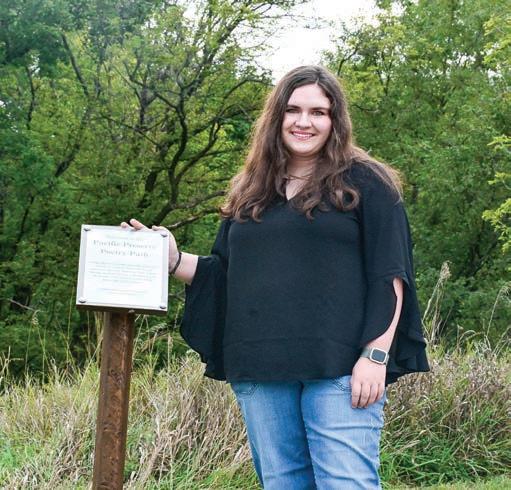
Fabulous Founder
Senior Gabby Burns stands next to a sign reading “Welcome to the Pacific Poetry Path,” celebrating the launch of the new trail featuring local poetry. The trail, part of her IB CAS project, displays poems from both professional and middle school poets
Photograph by Lydia Harlow
Photograph by Lydia Harlow
After the trail was fully set up, all that was left was to get the word out about it. Luckily for Burns, the park officials were willing to help.
“After meeting with Omaha Parks Department Marketing Manager, they have included it in their newsletter and posted it to social media. They also set up a competition where if someone tags Omaha Parks Department and the Poetry Path instagram in a picture with their favorite poem, they will be entered in a drawing to get ice skating passes,” Burns said.
The poetry trail encourages visitors to engage with both poetry and nature. The poems give people an opportunity to stop and enjoy not only the poem, but the surrounding scenery that the
writing describes.
“[I enjoy] just going out to the trail and seeing people read. It has been so much fun just to watch them laugh and talk about it on their way to read the next poem. So that’s been really rewarding,” Burns said.
IB Coordinator Rhonda Betzold got to see Burns’s progress throughout this project, and also watched her personal growth as she made her vision a reality.
“Gabby was very interested in this project from the very beginning. She encountered roadblocks and at several times it looked like it might not be possible the way she envisioned it. I’m so proud of her perseverance and passion for this project,” Betzold said.
The installation is currently planned to be up for about a year, at the Pacific Preserve. There are seven featured poems along the half-mile trail, which are themed around nature, a theme that Burns chose to show how the outdoors can inspire a writer.
“My goal with this is that it should get poets who maybe don’t always go outside in nature and enjoy the things that inspire poetry as much as they should. And so my hope is that this is a way to get poets back into nature, but also people who go into nature that don’t really seek out reading poetry to go and enjoy poems as well. Hopefully it’s a way to get families to do it together, too,” Burns said.
Even if the poetry path was intended to be temporary, both Burns and the park keepers are fond enough of it that they’re hoping to find a way to make it permanent. No matter how long it stands, however, it will represent a deep connection between poetry and nature that is unlike anything else in the state.
The Poetry Path is located on 16230 Pacific St, Omaha, NE 68118. It is roughly one mile long and takes about 30 to 45 minutes to walk and enjoy the scenery. The scenic walking trail preserves a natural space for pollinators such as bees and birds that play a crucial role in a healthy ecosystem. According to Visit Omaha
LYDIA HARLOW Sports Editor
The switch from fluorescent gym lights to bright, open sky and stadium lights is jarring. And when you add the challenges that come with playing outdoors-the wind, sun, and heat-- the volleyball team faced unpredictable conditions for their first major game of the 2025 season.
On August 21, instead of their usual games on gym floors, varsity volleyball played on a portable court placed on the football field at Buell. The team played two sets against both Millard West and Millard South in this historic match-up.
“Playing at Buell in such a big arena, it was a surreal moment,” senior Hannah Ehrenberg said. “The last time that an outdoor volleyball match took place like that in Nebraska was when the Huskers played on their football field, and so that was really cool to kind of carry that on.”
The Battle at Buell, inspired by UNL’s ‘Volleyball Day in Nebraska’ game in Memorial Stadium, and planned in collaboration with the coaches from the other two schools, attracted a larger, more enthusiastic crowd than ever before.
“The crowd was much louder and more involved in the game [at Buell]. They were cheering on specific players, and just looking into the crowd and seeing how the stands were absolutely packed was really an insane moment for me, just seeing how many people were watching us and cheering us on,” Ehrenberg said.
Volleyball games at MN typically draw a crowd of 100 people, often with only a small student section. At Buell, however, thousands more showed up, creating a dramatic shift in environment for the athletes.
“You never know, it’s female athletics, and sometimes here at home games we have just parents, and sometimes we have a student section. You just never really know how people are going to adopt it, but I thought the Millard community really embraced it and helped send it to the next level.”
Logistics for setting up such an unusual event were complicated, especially with obtaining and setting up a portable court; however, with help from groups, especially the football teams from each school, the event was able to run smoothly.
“We put the entire court together, laid out the mats underneath it, and then put each individual panel together, and helped set up the net… It felt really good to support the [volleyball] team, because they always come to our football games. They support us, so it felt good to support them,” junior Austin Ruhter said.

accountable and are just a close group,” junior Tresor Porter said.
They had to lean on each other a lot throughout the Battle at Buell, especially when facing outdoor elements, such as the wind and sun, that they don’t usually deal with in a typical game.

Setting The Bar: Freshman Andie Blomenkamp sets the ball during the first set against Millard South. They won in a close game, starting the night off strong.
Although coordinating this multifaceted event was difficult, the contributions from the schools, club teams, and local sponsors from around the city made the day possible.
Photograph by Lucas Day
Sophomore Ava Whitmarsh goes through the line, giving high fives to each teammate before the game. “[The community] is really supportive. Everybody is like one big family,” Whitmarsh said.
Photograph by Lydia Harlow
The overwhelming support for the volleyball team shattered their expectations, and they hope that support will continue as the season progresses.
“I never imagined there were going to be 4,000 people there,” varsity volleyball coach Lindsey Grant said.
“The club community really embraced this event. There were multiple clubs that were there and helped sponsor it. I think the volleyball community as a whole is pretty tight-knit in Nebraska, and anything volleyball-related is well promoted throughout the state,” Grant said.
As the sport of volleyball has been rapidly growing in popularity in Nebraska, the community has been coming together and providing support for one another within their own schools and throughout the city.
“[Our community] is like a family. We have our three rules: integrity, hard work, and family. We trust each other. We do team bonding, and every day we work hard at practice, giving 110% effort. We hold each other
“We had to adjust a lot because the sun was in our eyes, so we couldn’t see the ball, and since the court was on turf, it didn’t have that easy, more jumpable quality, and so we weren’t able to jump as high, especially at first,” Ehrenberg said. They couldn’t always see the ball, and so had to communicate excessively, warning each other of their blind spots.
“We would talk about who had what, but also the trust that we have in each other played a big role. We knew who would take what ball, and relied on them,” sophomore Ava Whitmarsh said.
The team quickly adapted, working together and relying on one another, growing their trust and camaraderie.
“We all kind of got adjusted and got used to it… It was hard, but I think it made us better as players to be able to adapt to out-of-system situations during the game,” Ehrenberg said.
The team is already looking ahead to future seasons, but given its logistical difficulty, it remains to be seen if this will be a recurring event.
“We’re looking into seeing if we want to do it on a regular basis or how we want to continue to grow it. We’ll see. Obviously, it’s very early. We’ve had some conversations, and this will probably not be an annual thing, but we’ll see what may or may not happen,” Grant said.
Even if it doesn’t become an annual tradition, the Battle at Buell shows the type of revamping and ingenuity that Grant is implementing in the volleyball program.
“We were making Nebraska high school history. We were the first high school team to play a game like that on a court at Buell. I think it’s awesome to have been a part of that, and I hope to have that legacy continued through the program that Grant is building,” Ehrenberg said.
Drawing a crowd of 4,000 is no small feat, and the Battle at Buell event marks an unforgettable start to what the team hopes will be a memorable season.
Co-Front Page Editor
ut of every classroom, lecture hall, and hallway, there is no space in the MN building busier than the gym. At times, it might be easier to get a parking spot at 7:55 than to catch an open slot in the weight room schedule.
Overcrowded sports facilities are a growing worry in the Millard community. In partnership with the Millard Public Schools Foundation and other generous donors, the GreenState Millard Activities Center is set to debut in the fall of 2026.
This state-of-the-art center will feature basketball and volleyball courts, an innovation lab, an esports lounge, multi-purpose classrooms, a sports performance gym, an indoor turf field, and a cross-country trail on its 40-acre site located off 204th and Q Street.
“Construction is now in progress, marking a major step forward in Millard’s commitment to community transformation — made possible entirely through private funding and generous donor support without the use of tax dollars,” Millard Public Schools (MPS) Foundation Chief Operations Officer Marilyn Chollett said.
“We knew that it was a need for our community because at the high school level and middle school level, our facilities are constantly being used. We wanted to try to relieve some of that pressure of use from outside communities by giving organizations a space to practice and compete,” Maly said.
The first challenge was finding a space large enough to house such a robust facility. In addition to room for multiple volleyball/basketball courts, parking was also a concern. For every inch of indoor space, there need-
zon is that there are around 45 to 50 acres that we’re going to develop. And on the weekends and evenings, we add additional parking to the facility because Horizon is not open,” Maly said.
As the activity center is still being constructed, the MN athletic department is considering how MN athletes will utilize the facility. A highlight of the abundant space is that everything will be in one place, eliminating the need to drive across town for different facilities.

Renovation Rendering:
Chollett oversees sponsorships, donor partnerships, and marketing for the activity center. She worked with GreenState Credit Union to give the activity center its full name, GreenState Millard Activities Center, which was announced in a naming rights partnership on August 25, 2025.
“GreenState Credit Union is very excited to be part of this project. Community giveback is core to our mission, so supporting the Activity Center is a perfect fit,” GreenState CEO Vic Israni said.
Although work on-site has just begun, plans for the activity center have been developing for many months. MN Activities Director Keith Maly, along with activities directors from high schools and middle schools across the district, was brought in on the project in the summer of 2024.


ed to be as much, if not more, space for parking. Lastly, it was important that the activity center was centralized within the district.
“We were also looking for a facility that was centrally located for all the high schools and all the middle schools. We didn’t want it somewhere way north for one school and then in the backyard of another,” Maly said.
The first site considered was the JCPenney building in Oakview Mall. The central location was perfect, but the building lacked the square footage needed for multiple athletic spaces. Knowing it would be near impossible to find a pre-existing building to fit their vision, it was decided that the GreenState Millard Activity Center would be built next to Horizon High School.
“The good thing about using the area where Hori-


“To make it more convenient for families, we started trying to put all aspects of sports programs together. We (MN) may be able to start weight training and conditioning at the activity center because the facility will employ a company that is going to strictly run the strength conditioning program,” Maly said.
Regardless of how MN athletes will engage with the facility, the MPS Foundation hopes an activity center with so much to offer will attract people from across the district.
“I think one of the things the activity center will allow is an opportunity to have more programs in the future than we have had in the present or in the past. Because of the fact that we were limited by the space that we could give to people, there were a lot of things that we would have to turn down,” Maly said.
In addition to the numerous traditional courts and fields, the GreenState Millard Activity Center also includes a lounge for an up-and-coming sport, Esports.
“This facility will provide amazing opportunities for our youth programs and high school students. I love basketball, so that is exciting, but I am very excited for the esports lab. Esports has really progressed over the years, and I look forward to seeing our students and community benefit from this awesome space,” Chollett said.
The development of the activity center will occur in phases. While not every aspect will be ready for the public by 2026, the facility will be ready to welcome community from across the district. So if you don’t find yourself at a Green State Millard Activity Center event, be sure to go take a look at this amazing space.




The cheer team expands its performances by adopting new dances, doubling their repetoire of sideline cheers
PARKER NEVILLE Staff Writer
As the band readies their instruments, the cheer team prepares itself on the sideline, thinking back to the movements they all memorized in the practices leading up to this. After years of the same routine, it is time for them to perform something new.
Whether they’re starting a cheer in the student section, dancing along to the music from the band, or performing stunts to captivate the audience, the team is always looking for ways to promote engagement from the audience. This year, to add to their performance on the sideline, the team introduced new dances to increase variety in their routines.
“We’ve always had the same four band dances, which we always do at games. And so this year, they gave us four new ones, so now we have eight to do, and so that just gives us a lot more selection,” junior Morgan Strong said.
The dances were choreographed by seniors like Brooklynn Spence. While this is the first time that the team has added extra dances to their routine, Spence and her teammates had thought about this in the past.
“My grade specifically has wanted to do [this] for the last couple years, but it’s senior decision, so now that we finally had the ability to do it, we decided to make the change instead of waiting for the next grade,” Spence said.
After they came up with the ideas for their new dances, the next step was to have everybody start learning them.
“We set videos out to learn through our communication, Band App, and then had them learn it, and then come to practice, and then we went over it to learn our ripples. It probably would take about 30 minutes of practicing a day just to keep the knowledge,” Spence said.
Having these extra dances also gave the team a chance to improve. While adding new choreography does take time to learn, spending that time can help team members develop skills that will prepare them for the season.
“It’s more prep material, just learning more stuff and having to quickly catch on to it. We were only given so much time to learn this stuff and put together and put it in front of the student section and people at
Jock Talk
What’s a pre-game tradition you have?
Drew Nelsen

football games. Obviously, there are changes in choreography all the time, so you just learn how to pick that up,” Spence said.
However, having this many dances presents a challenge to new members, especially freshmen. While many of the returning members only had to learn the four new dances, the newcomers had to learn all eight of them in a short period of time.
“It’s definitely stressful, especially because I’m in a lot of other activities. It’s a lot to memorize, and you just kind of have to practice a lot, [but] the coaches have definitely helped. They’ve been more lenient on the deadlines that I have to learn things, and the girls have been helpful in helping me remember stuff,” freshman Ella Ackerson said.
Many of the upperclassmen have stepped in to offer their guidance to those who are learning these dances for the first time. Through these interactions, the dances started to become more than just a way to diversify the team’s performances.
“It helped create more bonding in the beginning of the season, because when they sent all these out, we had to teach all the underclassmen eight dances instead of four, so it just gave everyone a really good opportunity to work together and learn these motions, because we would learn them at practices together,” Strong said.
al and helping people out and going to the different events,” Spence said.
Coach Connor Churchill has also noticed the team’s increased efforts this year, with both the new dances and the stronger community.
“My goal for the team this season is to make memories with one another and to leave this year recog-

The cheer team hypes up the student section at the Battle at Buell. They performed alongside cheer teams from the other two Millard Schools on the sidelines, keeping the crowd engaged.
Photograph by Lydia Harlow
Having this opportunity to bond has also helped the team’s camaraderie during their performances. In addition, Spence notes that emphasizing the community is beneficial for the team overall.
“Just having a positive attitude as a senior leaks into the other grades and just helps everyone have a more positive outlook on everything. And [you can] help the community by being just a better person in gener-
We have position and team meetings, and then [Burrell] gives us a lights out, where we visualize whats going to happen in the game.
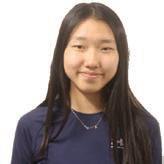
I usually start out with stretching so I can get the flexibility I need, then I do my eight-iron and nine-iron.
nizing that what we do is larger than the individual,” Churchill said.
Through their expanded repertoire, the cheer team has been able to prepare a show that is much different than their previous years. With their sights set on qualifying for Nationals in February, the team is feeling prepared to succeed in the upcoming season.

I put on my headband, and sometimes I eat a few dates before the game if I need energy.
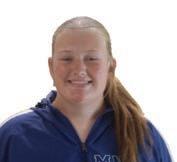
As a team, we all ride the bus together. The atmoshphere is great, we’re always talking and listening to music.